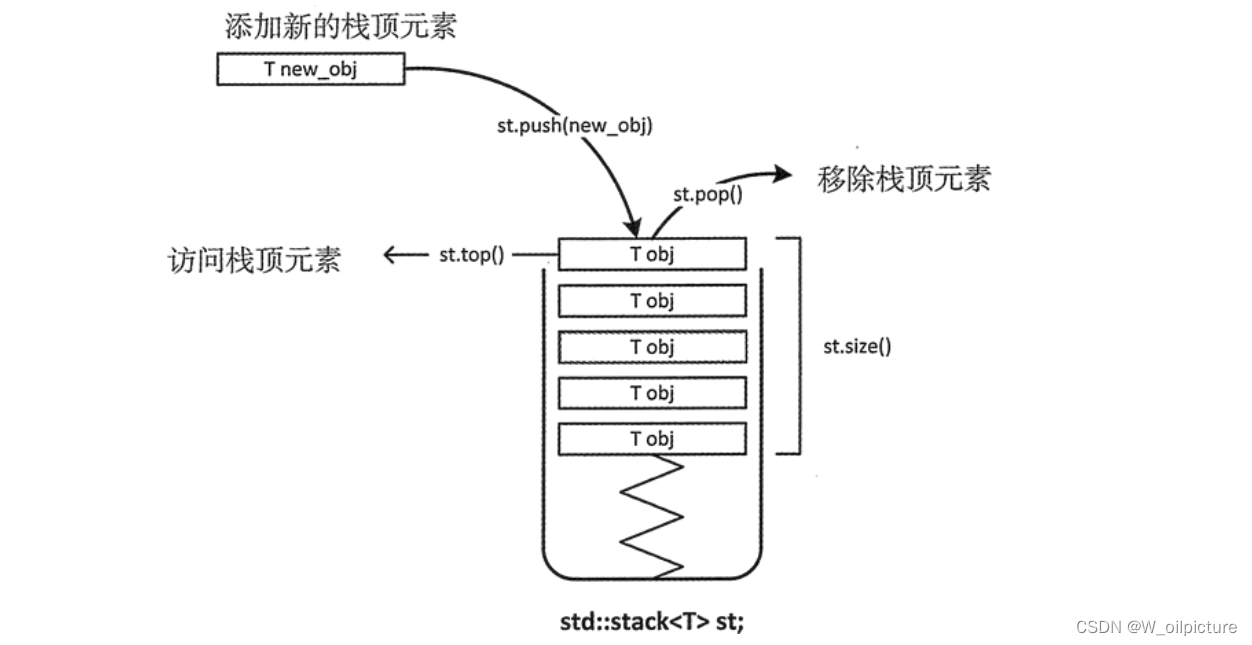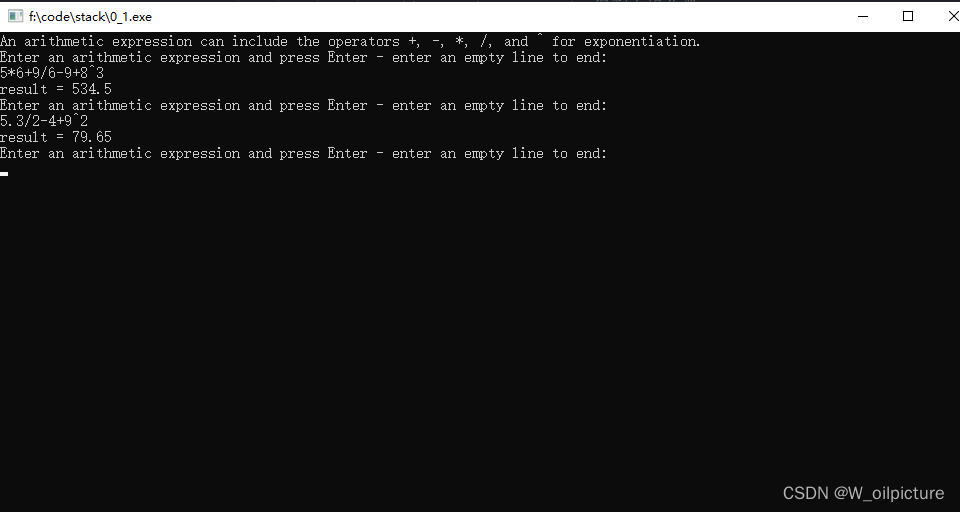前言
人生如逆旅,我亦是行人。
容器适配器是一个封装了序列容器的类模板,它在一般序列容器的基础上提供了一些不同的功能。之所以称作适配器,是因为它可以通过适配容器现有的接口来提供不同的功能。
stack< T >容器适配器中的数据是以LIFO的方式组织的,这和自助餐馆中堆叠的盘子、箱子中的一堆书类似。

堆栈操作
stack 容器有广泛的应用。例如,编辑器中的 undo (撤销:Ctrl + Z ) 机制就是用堆栈来记录连续的变化。撤销操作可以取消最后一个操作,这也是发生在堆栈顶部的操作。编译器使用堆栈来解析算术表达式,当然也可以用堆栈来记录 C++ 代码的函数调用。下面展示了如何定义一个用来存放字符串对象的 stack 容器:
std::stack<std::string> words;
stack<int> S; //定义一个存储整数类型的栈
stack 容器适配器的模板有两个参数:
- 第一个参数是:存储对象的类型;
- 第二个参数是:底层容器的类型。
定义一个使用 list 的堆栈:
std::stack<std::string, std::list<std::string>> fruit;
top():返回一个栈顶元素的引用,类型为T&。如果栈为空,返回值未定义。push(const T& obj):可以将对象副本压入栈顶。这是通过调用底层容器的 push_back() 函数完成的。push(T&& obj):以移动对象的方式将对象压入栈顶。这是通过调用底层容器的有右值引用参数的push_back()函数完成的。pop():弹出栈顶元素。size():返回栈中元素的个数。empty():在栈中没有元素的情况下返回 true。emplace():用传入的参数调用构造函数,在栈顶生成对象。swap(stack<T> & other_stack):将当前栈中的元素和参数中的元素交换。参数所包含元素的类型必须和当前栈的相同。对于 stack 对象有一个特例化的全局函数swap()可以使用。
stack 模板也定义了复制和移动版的 operator=() 函数,因此可以将一个 stack 对象赋值给另一个 stack 对象。stack 对象有一整套比较运算符。比较运算通过 字典 的方式来比较底层容器中相应的元素。字典比较是一种用来对字典中的单词进行排序的方式。依次比较对应元素的值,直到遇到两个不相等的元素。第一个不匹配的元素会作为字典比较的结果。如果一个 stack 的元素比另一个 stack 的多,但是所匹配的元素都相等,那么元素多的那个 stack 容器大于元素少的 stack 容器。
用 stack 容器来实现一个简单的计算器程序。这个程序支持一些基本的加、 减、乘、除、幂操作。它们分别对应运算符 +、-、*、/、^。幂操作由定义在头文件 cmath 中的 pow() 函数提供。表达式以单行字符串的形式读入,可以包含空格。在解析字符串之前可以使用 remove() 算法来移除输入表达式中的空格,然后再执行这个表达式所包含的运算。
- 定义一个函数来获取运算符的优先级:
inline是C++关键字,在函数声明或定义中,函数返回类型前加上关键字inline,即可以把函数指定为 内联函数。这样可以解决一些频繁调用的函数大量消耗栈空间(栈内存)的问题。关键字inline必须与函数定义放在一起才能使函数成为内联函数,仅仅将inline放在函数声明前面不起任何作用。inline是一种“用于实现”的关键字,而不是一种“用于声明”的关键字。
size_t是一些C/C++标准在<stddef.h>中定义的,size_t: 类型表示C中任何对象所能达到的最大长度,它是无符号整数。
const:使用const关键字对变量加以限定,使变量的值不能被改变,在整个作用域中都保持固定。
inline size_t precedence(const char op)
{
if(op == '+' || op == '-')
return 1;
if(op == '*' || op == '/')
return 2;
if(op == '^')
return 3;
throw std:: runtime_error {
string{
"invalid operator:"} + op}; //运行时报错:无效操作符
}
+ 和 - 的优先级最低,其次是 * 和 /,最后是 ^。运算符的优先级决定了它们在表达式中的执行顺序。如果参数是一个不支持的运算符,那么会拋出一个 runtime_error 异常对象。异常对象构造函数中的字符串参数,可以在 catch 代码块中通过调用对象的 what() 函数获得。
通过从左到右扫描的方式来分析输入表达式,并且会将运算符保存到 stack 容器 operators 中。操作数存放在 stack 容器 operands 中。所有的运算符都需要两个操作数,所以每执行一次运算,都需要获取一个 operators 栈顶的运算符,以及两个 operands 栈顶的操作数。运算由下面的函数执行:
// Execute an operation:执行一个操作
double execute(std::stack<char>& ops, std::stack<double>& operands)
{
double result {
};
double rhs {
operands.top()}; // Get rhs...
operands.pop(); // ...and delete from stack
double lhs {
operands.top()}; // Get lhs...
operands.pop(); // ...and delete from stack
switch (ops.top()) // Execute current op
{
case '+':
result = lhs + rhs;
break;
case '-':
result = lhs - rhs;
break;
case '*':
result = lhs * rhs;
break;
case '/':
result = lhs / rhs;
break;
case '^':
result = std::pow(lhs, rhs);
break;
default:
//运行时报错:无效操作符
throw std::runtime_error {
string{
"invalid operator: "} + ops.top()};
}
ops.pop(); // Delete op just executed:删除刚被执行的操作符
operands.push(result);
return result;
}
函数的参数是两个 stack 容器的引用。可以用 operands 容器的 top() 函数获取操作数。 top() 函数只能得到栈顶元素;为了访问下一个元素,必须通过调用 pop() 来移除当前栈顶元素。
注意,栈中操作数的顺序是相反的,因此得到的第一个操作数是运算的右操作数。operators 容器顶部的元素用来在 switch 中选择运算。在它不匹配任何一个 case 分支时,会拋出一个异常来表明这个运算符是无效的。
main.cpp:
// 一个使用堆栈容器的简单计算器
#include <cmath> // For pow() function
#include <iostream> // For standard streams
#include <stack> // For stack<T> container
#include <algorithm> // For remove()
#include <stdexcept> // For runtime_error exception
#include <string> // For string class
using std::string;
// Returns value for operator precedence:返回操作符优先级的值
inline size_t precedence(const char op)
{
if (op == '+' || op == '-')
return 1;
if (op == '*' || op == '/')
return 2;
if (op == '^')
return 3;
throw std::runtime_error {
string {
"invalid operator in precedence() function: "} + op};
}
// Execute an operation:执行一个操作
double execute(std::stack<char>& ops, std::stack<double>& operands)
{
double result {
};
double rhs {
operands.top()}; // Get rhs...
operands.pop(); // ...and delete from stack
double lhs {
operands.top()}; // Get lhs...
operands.pop(); // ...and delete from stack
switch (ops.top()) // Execute current op
{
case '+':
result = lhs + rhs;
break;
case '-':
result = lhs - rhs;
break;
case '*':
result = lhs * rhs;
break;
case '/':
result = lhs / rhs;
break;
case '^':
result = std::pow(lhs, rhs);
break;
default:
throw std::runtime_error {
string{
"invalid operator: "} + ops.top()}; //运行时报错:无效操作符
}
ops.pop(); // Delete op just executed:删除刚被执行的操作符
operands.push(result);
return result;
}
int main()
{
std::stack<double> operands; // Push-down stack of operands:操作数下推堆栈
std::stack<char> operators; // Push-down stack of operators:操作符下推堆栈
string exp; // Expression to be evaluated:需要计算的表达式
//算术表达式可以包含运算符+、-、*、/和^用于求幂
std::cout << "An arithmetic expression can include the operators +, -, *, /, and ^ for exponentiation." << std::endl;
try
{
while (true)
{
//输入算术表达式并按Enter -输入空行结束
std::cout << "Enter an arithmetic expression and press Enter - enter an empty line to end:" << std::endl;
std::getline(std::cin, exp, '\n');
if (exp.empty()) break;
// Remove spaces
exp.erase(std::remove(std::begin(exp), std::end(exp), ' '), std::end(exp));
size_t index {
}; // Index to expression string:表达式字符串的索引
// Every expression must start with a numerical operand:每个表达式必须以一个数值操作数开始
operands.push(std::stod(exp, &index)); // Push the first (lhs) operand on the stack:将第一个操作数压入栈中
while (true)
{
operators.push(exp[index++]); // Push the operator on to the stack:将操作符压入栈中
// Get rhs operand:得到右操作数
size_t i {
}; // Index to substring:索引子串
operands.push(std::stod(exp.substr(index), &i)); // Push rhs operand:将右操作数压入栈中
index += i; // Increment expression index:增量表达式
if (index == exp.length()) // If we are at end of exp...
{
while (!operators.empty()) // ...execute outstanding ops
execute(operators, operands);
break;
}
// If we reach here, there's another op...
// If there's a previous op of equal or higher precedence execute it:如果前一个op的优先级相等或更高,则执行它
while (!operators.empty() && precedence(exp[index]) <= precedence(operators.top()))
execute(operators, operands); // Execute previous op.
}
std::cout << "result = " << operands.top() << std::endl;
}
}
catch (const std::exception& e)
{
std::cerr << e.what() << std::endl;
}
std::cout << "Calculator ending..." << std::endl;
}
while循环包含在一个 try 代码块中,这样就可以捕获抛出的任何异常。在 catch 代码块中,调用异常对象的成员函数 what() 会将错误信息输出到标准错误流中。在一个死循环中执行输入操作,当输入一个空字符串时,循环结束。可以使用 remove() 算法消除非空字符串中的空格。remove() 不能移除元素,而只能通过移动元素的方式来覆盖要移除的元素。
为了移除 exp 字符串中剩下的多余元素,可以用两个迭代器作为参数调用
erase()(erase的用法 )。其中第一个迭代器由remove()返回,指向字符串的最后一个有效元素的后面位置。第二个迭代器是字符串原始状态的结束迭代器。这两个迭代器指定范围的元素会被删除。
每个浮点操作数的值都是用定义在头文件
string中的stod()函数获取的(stod的用法)。这会 将第一个字符串参数中的字符序列转换为 double 值。 函数会从第一个表示有效浮点数的字符串的第一个字符开始,获取最长字符序列。第二个参数是一个整型指针,保存的是字符串中非数字部分第一个字符的索引。string头文件中定义了stod()函数,它可以返回一个float值。Stod()会返回一个long double值。
因为所有的运算符都需要两个操作数,所以有效的输入字符串格式总是为 operand op operand op operand,等等。序列的第一个和最后一个元素都是操作数,每对操作数之间有一个运算符。因为有效表达式总是以操作数开头,所以第一个操作数在分析表达式的嵌套循环之前被提取出来。在循环中,输入字符串的运算符会被压入 operators 栈。在确认没有到达字符串末尾后,再从 exp 提取第二个操作数。这时,stod() 的第一个参数是从 index 开始的 exp 字符串,它是被压入 operators 栈的运算符后的字符。非数字字符串的第一个索引保存在i中。因为 i 是相对于 index 的,所以我们会将 index 加上 i 的值,使它指向操作数后的一个运算符(如果是 exp 中的最后一个操作数,它会指向字符串末尾的下一个位置)。
当 index 的值超过 exp 的最后一个字符时,会执行 operators 容器中剩下的运算符。如果没有到达字符串末尾,operators 容器也不为空,我们会比较 operators 栈顶运算符和 exp 中下一个运算符的优先级。如果栈顶运算符的优先级高于下一个运算符,就先执行栈顶的运算符。否则,就不执行栈顶运算符,在下一次循环开始时,将下一个运算符压入 operators 栈。通过这种方式,就可以正确计算出带优先级的表达式的值。
结果:
